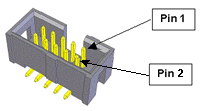
RS-485 is a multi-drop serial communication interface. At the application level, it can transmit and receive data in a manner similar to a RS-232 interface with the added benefit that the communication lines can be daisy chained between multiple nodes instead of requiring point-to-point wiring. Within GPL application programs, this port is referenced as "/dev/com4."
For reliable communications, RS-485 lines must be terminated at both ends of the daisy chain and must not have any termination at interior nodes. The controller's RS-485 interface includes hardwired termination. Therefore, the controller must always be at one end of the RS-485 daisy chain.
The RS-485 interface is not available for interfacing to 3rd party devices when the controller is embedded in a PreciseFlex robot such as the PrecisePlace and PreciseFlexTM. In these robots, this interface is dedicated to communicating with the built-in Serial I/O boards. See Figure 7-65 and Table 7-48.

| Pin | Description |
|---|---|
|
1 |
24VDC |
|
2 |
|
|
3 |
GND |
|
4 |
GND |
|
5 |
GND |
|
6 |
VCC |
|
7 |
GND |
|
8 |
RS485+ |
|
9 |
RS485- |
|
10 |
GND |
|
User Plug Part No |
AMP 746285-1 or Molex 22-55-2101 or 90142-0010. For the Molex plug, use Molex pins 16-02-0103 and Molex crimp tool 63811-1000. |